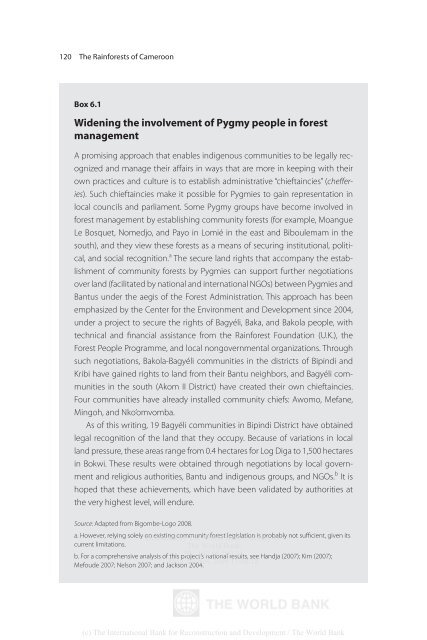The Rainforests of Cameroon - PROFOR
The Rainforests of Cameroon - PROFOR
The Rainforests of Cameroon - PROFOR
- No tags were found...
Create successful ePaper yourself
Turn your PDF publications into a flip-book with our unique Google optimized e-Paper software.
120 <strong>The</strong> <strong>Rainforests</strong> <strong>of</strong> <strong>Cameroon</strong>Box 6.1Widening the involvement <strong>of</strong> Pygmy people in forestmanagementA promising approach that enables indigenous communities to be legally recognizedand manage their affairs in ways that are more in keeping with theirown practices and culture is to establish administrative “chieftaincies” (chefferies).Such chieftaincies make it possible for Pygmies to gain representation inlocal councils and parliament. Some Pygmy groups have become involved inforest management by establishing community forests (for example, MoangueLe Bosquet, Nomedjo, and Payo in Lomié in the east and Biboulemam in thesouth), and they view these forests as a means <strong>of</strong> securing institutional, political,and social recognition. a <strong>The</strong> secure land rights that accompany the establishment<strong>of</strong> community forests by Pygmies can support further negotiationsover land (facilitated by national and international NGOs) between Pygmies andBantus under the aegis <strong>of</strong> the Forest Administration. This approach has beenemphasized by the Center for the Environment and Development since 2004,under a project to secure the rights <strong>of</strong> Bagyéli, Baka, and Bakola people, withtechnical and financial assistance from the Rainforest Foundation (U.K.), theForest People Programme, and local nongovernmental organizations. Throughsuch negotiations, Bakola-Bagyéli communities in the districts <strong>of</strong> Bipindi andKribi have gained rights to land from their Bantu neighbors, and Bagyéli communitiesin the south (Akom II District) have created their own chieftaincies.Four communities have already installed community chiefs: Awomo, Mefane,Mingoh, and Nko’omvomba.As <strong>of</strong> this writing, 19 Bagyéli communities in Bipindi District have obtainedlegal recognition <strong>of</strong> the land that they occupy. Because <strong>of</strong> variations in localland pressure, these areas range from 0.4 hectares for Log Diga to 1,500 hectaresin Bokwi. <strong>The</strong>se results were obtained through negotiations by local governmentand religious authorities, Bantu and indigenous groups, and NGOs. b It ishoped that these achievements, which have been validated by authorities atthe very highest level, will endure.Source: Adapted from Bigombe-Logo 2008.a. However, relying solely on Delivered existing community by <strong>The</strong> World forest Bank legislation e-library is probably to: not sufficient, given itscurrent limitations.<strong>The</strong> World Bankb. For a comprehensive analysis <strong>of</strong> this project’s IP : 192.86.100.34national results, see Handja (2007); Kim (2007);Mefoude 2007; Nelson 2007; and JacksonMon, 092004.Nov 2009 17:06:18(c) <strong>The</strong> International Bank for Reconstruction and Development / <strong>The</strong> World Bank
















